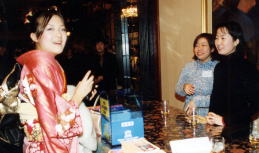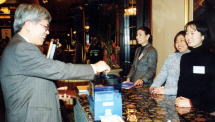No.194-4
| Meguro Board of Education Members Organize "Terakoya Donation"at
the Coming-of-Age Ceremonyü@ |
 ü@The coming-of-age ceremony for the young Meguro residents was held on
January 13 at the Westin Hotel in Ebisu.ü@Young energy wafted throughout
the elegant Galaxy Room and the gatherings around the tables separated
by districts were like class reunions.ü@For the first time, the "Terakoya
Donation Box" made its debut at the venue of the
ü@The coming-of-age ceremony for the young Meguro residents was held on
January 13 at the Westin Hotel in Ebisu.ü@Young energy wafted throughout
the elegant Galaxy Room and the gatherings around the tables separated
by districts were like class reunions.ü@For the first time, the "Terakoya
Donation Box" made its debut at the venue of the  coming-of-age ceremony.ü@
coming-of-age ceremony.ü@
5 members of Meguro UNESCO, mostly the young adults, assisted the board of education members with the hope of becoming a role model for the rest of Japan in spreading the consciousness among those joining the society the idea of contributing to the society.ü@The entire amount of \11,183 collected was donated to the World Terakoya Movement through Meguro UNESCO.
Photo Left:ü@Donor #1ü@Photo Right:ü@Deputy Superintendent of Meguro Board of Education also makes a donation.ü@From right to left - Ms. Morita, Ms. Aoki, and Ms. Kuniyasu of Meguro UNESCO.
| Report ü@ü@Current Situation and Future ProblemsFacing the UNESCO World Terakoya Movement |
|
ü@On January 15th at 6:00pm, Professor Chiba of International Christian
University and the chairperson of the World Terakoya Movement Committee
for the National Federation of UNESCO Associations inü@Japan (NFUAJ) gave
a lecture on the background, current situation and the future problems
of the movement.ü@The following is a brief summary of topics covered in
his lecture.
ü@
The World Terakoya Movement began in 1990, designated as the "International Learning Year".ü@At the time, the movement was called "UNESCO Core Action Learning Center" with NFUAJ supporting its own learning program in the developing countries.ü@The efforts were then combined to form the concept of "existing together", and the program name was changed to the present "World Terakoya Movement".ü@Among many international organizations that placed importance in spreading elementary education, the World Terakoya Movement works together with the field NGO's and project teams involved in learning programs as partners instead of merely supporting their programs.ü@Furthermore, study tours for young people are being organized in order to better understand the local situation and to effectuate this movement through building close working relationships with field workers in each country.ü@The study tours are funded through the domestic fund-raising activity of collecting damaged or unused pre-paid postcards.
ü@The movement is highly valued internationally as "an example of
international aid having a philosophy", and the word "Terakoya"
has now become an international word.ü@But the reality is that there are
still 8.8 hundred million illiterate people in the developing countries
with 64% being women.ü@In order to realize the goal of "Education
for All", the UN will execute a "10 Year Learning Program"
starting this year in 2003.
ü@The question is "how should the learning education be conducted
in the future?"ü@The program to teach reading and writing should be
terminated and be changed to programs to teach skills necessary to improve
the living and economical standards of the developing countries.ü@There
is a need for the World Terakoya Movement to get involve with the culture
of each country and create programs that are different from those of other
NGO's.ü@Furthermore, although our involvement had been mainly concentrated
in the Asian countries up to now, we will need to consider how we can support
the situation in Africa in the future.
ü@I have summarized the contents of the lecture with the help of Professor
Chiba's article in the January Edition of "UNESCO" as a reference.ü@Please
read this article for further details.ü@Additionally, you can look forward
to the contents of the lecture in the NFUAJ book.ü@Many of Professor Chiba's
students from ICU and the young adults from Meguro UNESCO attended the
lecture, which I thought was a good indication of the future development
of this movement.
ü@The lecture was held at Naka-Meguro GT Plaza, located a minute walk from
Naka-Meguro Station.ü@There is a multi-purpose hall and a public library
in the same building and I highly recommend taking advantage of this facility
for future concerts and lectures.*ü@Refer to page 6 for information on
the March 24th UNESCO lecture, "Japan's Policy on International Education
Aid"ü@ü@ü@ü@ü@ü@ü@By Yukiko Katsuokaü@Public Relations Committee Member
ü@
A video showing, introducing the learning programs in Vietnam preceded Prof. Chiba's lecture.ü@The following 6 volumes from the series of videos produced by NFUAJ are available at our office for viewing or rental.ü@Each video is 10 min. and in VHS.
ć@"Learning About UNESCO Through A Quiz"ü@ćA"What Is The
'World Terakoya Movement'"ü@ćB"Life of Chinda and Sobanary on
the Lake" (Lake Tonle Sap, Cambodia) ćC"Keep It Up Sadika"
(Nepal)ü@ćD"Welcomingü@ü@ü@ü@Rostam as a Young Reporter" (Bangladesh)ü@ćE"First
Love Letter"ü@(Vietnam)
Next Page
 ü@The coming-of-age ceremony for the young Meguro residents was held on
January 13 at the Westin Hotel in Ebisu.ü@Young energy wafted throughout
the elegant Galaxy Room and the gatherings around the tables separated
by districts were like class reunions.ü@For the first time, the "Terakoya
Donation Box" made its debut at the venue of the
ü@The coming-of-age ceremony for the young Meguro residents was held on
January 13 at the Westin Hotel in Ebisu.ü@Young energy wafted throughout
the elegant Galaxy Room and the gatherings around the tables separated
by districts were like class reunions.ü@For the first time, the "Terakoya
Donation Box" made its debut at the venue of the  coming-of-age ceremony.ü@
coming-of-age ceremony.ü@